Additive synthesis is a sound synthesis technique that creates timbre by adding sine waves together.

Bass ( BAYSS) (also called bottom end) describes tones of low (also called "deep") frequency, pitch and range from 16 to 256 Hz (C0 to middle C4) and bass instruments that produce tones in the low-pitched range C2-C4. They belong to different families of instruments and can cover a wide range of musical roles. Since producing low pitches usually requires a long air column or string, and for stringed instruments, a large hollow body, the string and wind bass instruments are usually the largest instruments in their families or instrument classes.

In speech science and phonetics, a formant is the broad spectral maximum that results from an acoustic resonance of the human vocal tract. In acoustics, a formant is usually defined as a broad peak, or local maximum, in the spectrum. For harmonic sounds, with this definition, the formant frequency is sometimes taken as that of the harmonic that is most augmented by a resonance. The difference between these two definitions resides in whether "formants" characterise the production mechanisms of a sound or the produced sound itself. In practice, the frequency of a spectral peak differs slightly from the associated resonance frequency, except when, by luck, harmonics are aligned with the resonance frequency.

In music, harmony is the process by which individual sounds are joined together or composed into whole units or compositions. Often, the term harmony refers to simultaneously occurring frequencies, pitches, or chords. However, harmony is generally understood to involve both vertical harmony (chords) and horizontal harmony (melody).

An overtone is any harmonic with frequency greater than the fundamental frequency of a sound. In other words, overtones are all pitches higher than the lowest pitch within an individual sound; the fundamental is the lowest pitch. While the fundamental is usually heard most prominently, overtones are actually present in any pitch except a true sine wave. The relative volume or amplitude of various overtone partials is one of the key identifying features of timbre, or the individual characteristic of a sound.
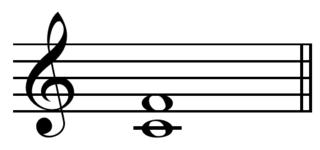
A fourth is a musical interval encompassing four staff positions in the music notation of Western culture, and a perfect fourth is the fourth spanning five semitones. For example, the ascending interval from C to the next F is a perfect fourth, because the note F is the fifth semitone above C, and there are four staff positions between C and F. Diminished and augmented fourths span the same number of staff positions, but consist of a different number of semitones.

IRCAM is a French institute dedicated to the research of music and sound, especially in the fields of avant garde and electro-acoustical art music. It is situated next to, and is organisationally linked with, the Centre Pompidou in Paris. The extension of the building was designed by Renzo Piano and Richard Rogers. Much of the institute is located underground, beneath the fountain to the east of the buildings.
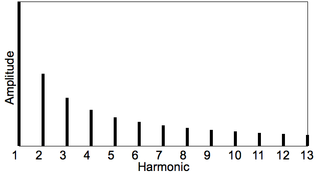
In music, inharmonicity is the degree to which the frequencies of overtones depart from whole multiples of the fundamental frequency.
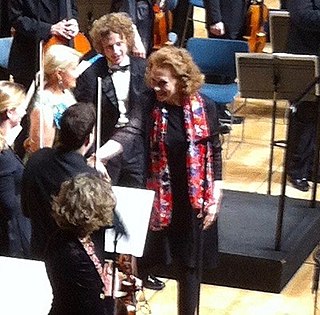
Kaija Anneli Saariaho is a Finnish composer based in Paris, France. During the course of her career, Saariaho has received commissions from the Lincoln Center for the Kronos Quartet and from IRCAM for the Ensemble Intercontemporain, the BBC, the New York Philharmonic, the Salzburg Music Festival, the Théâtre du Châtelet in Paris, and the Finnish National Opera, among others. In a 2019 composers' poll by BBC Music Magazine, Saariaho was ranked the greatest living composer.

Gérard Henri Grisey was a twentieth-century French composer of contemporary classical music. His work is often associated with the Spectralist Movement in music, of which he was a major pioneer.
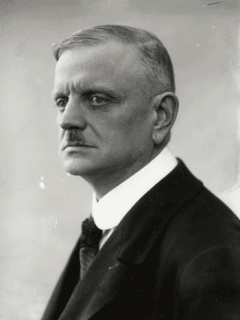
Symphony No. 7 in C major, Op. 105, was the final published symphony of the Finnish composer, Jean Sibelius. Completed in 1924, Symphony No. 7 is notable for being a one-movement symphony, in contrast to the standard symphonic formula of four movements. It has been described as "completely original in form, subtle in its handling of tempi, individual in its treatment of key and wholly organic in growth" and "Sibelius's most remarkable compositional achievement".

In music, consonance and dissonance are categorizations of simultaneous or successive sounds. Within the Western tradition, some listeners associate consonance with sweetness, pleasantness, and acceptability, and dissonance with harshness, unpleasantness, or unacceptability, although there is broad acknowledgement that this depends also on familiarity and musical expertise. The terms form a structural dichotomy in which they define each other by mutual exclusion: a consonance is what is not dissonant, and a dissonance is what is not consonant. However, a finer consideration shows that the distinction forms a gradation, from the most consonant to the most dissonant. In casual discourse, as Hindemith stressed, "The two concepts have never been completely explained, and for a thousand years the definitions have varied". The term sonance has been proposed to encompass or refer indistinctly to the terms consonance and dissonance.

Spectral music uses the acoustic properties of sound – or sound spectra – as a basis for composition.
Tristan Murail is a French composer associated with the "spectral" technique of composition. Among his compositions is the large orchestral work Gondwana.
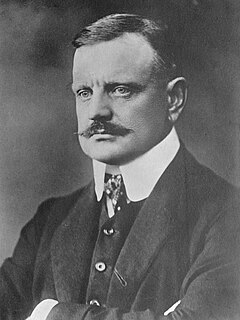
The Lemminkäinen Suite, Op. 22, is a four-movement symphonic poem for orchestra completed in 1895 by the Finnish composer Jean Sibelius. The piece was originally conceived as Veneen luominen, an opera with a mythological setting, before the work took form as a suite. Its story is based on the heroic character Lemminkäinen from the Kalevala, a collection of Finnish folklore and mythology epic poetry. The second movement, The Swan of Tuonela, is the most popular of the four movements and is often performed on its own.
OpenMusic (OM) is an object-oriented visual programming environment for musical composition based on Common Lisp. It may also be used as an all-purpose visual interface to Lisp programming. At a more specialized level, a set of provided classes and libraries make it a very convenient environment for music composition.

Partiels is a 1975 music composition by French composer Gérard Grisey. Written for 18 instruments, the piece is considered a defining work of spectral music. Many second- and third-generation spectral composers cite Partiels as causing their initial interest in the spectral outlook. It is the third piece in Grisey's cycle, Les Espaces Acoustiques.
Désintégrations, for 17 musical instruments and computer generated tape (1982–83) is a musical composition of spectral music by Tristan Murail, commissioned for IRCAM, Paris. The piece is more discontinuous than Murail's earlier composition Gondwana, owing in part to the use of dramatic silences throughout and particularly in the 6th section. According to Julian Anderson,
"although the tape does not attempt to 'simulate' any particular instrument, an organic unity between it and the orchestra is established such that the two blend perfectly. The title refers to this process of voyaging inside sounds and exploring their inner life; sounds melt before us, allowing us to discover their interior."
Mortuos Plango, Vivos Voco for eight-track tape is a musical composition created in 1980 by Jonathan Harvey, with the assistance of Stanley Haynes and Xavier Rodet, commissioned by the Centre Georges Pompidou in Paris. The two sounds contrasted are the tenor bell at Winchester Cathedral, England and the voice of the composer's son Dominic, at the time a chorister there, both recorded by John Whiting. The text is taken from that written on the bell: Horas Avolantes Numero, Mortuos Plango: Vivos ad Preces Voco. Music V was used to analyze and transform the sounds.

The Wood Nymph, Op. 15, is a programmatic tone poem for orchestra composed in 1894 and 1895 by the Finnish composer Jean Sibelius. The ballade, which premiered on 17 April 1895 in Helsinki, Finland, with Sibelius conducting, follows the Swedish writer Viktor Rydberg's 1882 poem of the same title, in which a young man, Björn, wanders into the forest and is seduced and driven to despair by a skogsrå, or wood nymph. Organizationally, the tone poem consists of four informal sections, each of which corresponds to one of the poem's four stanzas and evokes the mood of a particular episode: first, heroic vigor; second, frenetic activity; third, sensual love; and fourth, inconsolable grief.














